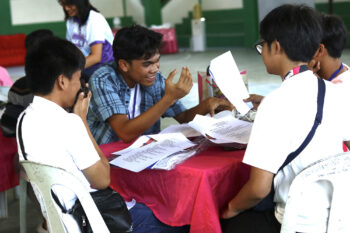LINAMON, Lanao del Norte (MindaNews / 15 March) –Lanao del Norte’s first home-grown Catholic priest who became known for his peace-building efforts, interfaith dialogue ministry and as a pioneer in Mindanao theatre, succumbed to pneumonia Sunday noon in a hospital here.
Fr. Rodulfo “Dong” Galenzoga, who would have turned 76 on April 13, had earlier survived COVID-19.
Panfilo Labunog, Galenzoga’s brother in-law told said the priest, the youngest among eight siblings, had recovered from COVID-19 and was supposed to have been discharged but succumbed to pneumonia at 12:35 noon at the Mercy Hospital here.
The Chancery of the Diocese of Iligan said Galenzoga was “freed of COVID but died of complications.”
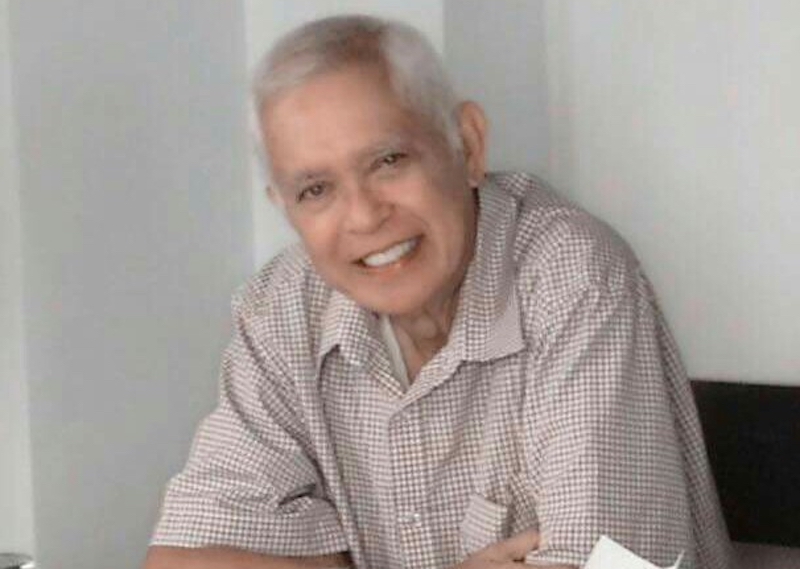 Fr. Rodulfo Galenzoga. (Photo from Fr. Galenzoga’s FB account)
Fr. Rodulfo Galenzoga. (Photo from Fr. Galenzoga’s FB account)
Galenzoga was ordained in his hometown, Tubod, now the capital town of Lanao del Norte, on December 23, 1969. He celebrated his golden jubilee as priest in 2019 at Dapit-Alim, a sanctuary he co-founded with Kahigalaan ni Hesus (KH) between Tubod and Kolambugan towns in Lanao del Norte, and reunited with friends in Davao City in February 2020 for mass and dinner to celebrate a life well lived in his 50 years of priesthood.
He and the KH founded Dapit-Alim to be “a place for prayer, contemplation, meditation, and for retreats,” for the tired and weary, for those seeking answers to faith questions, and for those with a passion for inter-faith dialogue with Muslim and Lumad brothers and sisters.
War in the 70s, Martial Law and Priesthood
The war in the 1970s and the declaration of martial law “contextualized” Galenzoga’s priesthood, according to an essay he wrote titled “A Josefino in the Ministry of Interreligious Dialogue,” published in 2012 in Insta, the official publication of the San Jose Major Seminary at the Ateneo de Manila University where he finished his theological seminary formation.
“The outbreak of the Mindanao war in the early seventies and the imposition of martial law contextualized my priesthood,” he wrote.
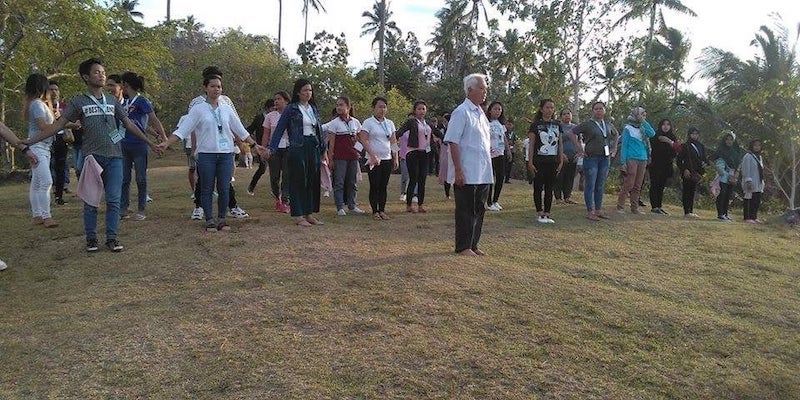 Fr. Dong Galenzoga teaches Shibashi to young Christian, Muslim and Lumad leaders at Dapit-Alim in Lanao del Norte. Photo by Abel Moya
Fr. Dong Galenzoga teaches Shibashi to young Christian, Muslim and Lumad leaders at Dapit-Alim in Lanao del Norte. Photo by Abel Moya
“We were in the midst of our people’s high hopes in their struggle for justice and peace. Indeed, my early years in the ministry were of deep joy and creativity, but also of pain and paralyzing fear. There was so much violence, injustice and hate brought by the senseless violations of human rights. However, those years were also times of intense hope for the country, faith in the goodness of human nature, and above all, trust in the abiding presence of God even in the darkest night,” he said.
“I will never forget the hundred and one burned and mutilated dead bodies of both Muslims and Christians, the thousand and one faces of horror, hunger and despair of evacuees. I will forever remember with deep gratitude the friends and companions who generously and valiantly offered their lives in the struggle that our people may someday reach the Promised Land, Mindanao,” Galenzoga recalled.
Struggle for land, love, freedom and life
He served as chaplain of the Mindanao State University in Marawi City and was a mentor to priests like Fr. Teresito Soganub, who also went into interfaith dialogue and also served as chaplain of the MSU. Soganub was among the hostages in the Marawi Siege of 2017. He passed away in his sleep in July last year.
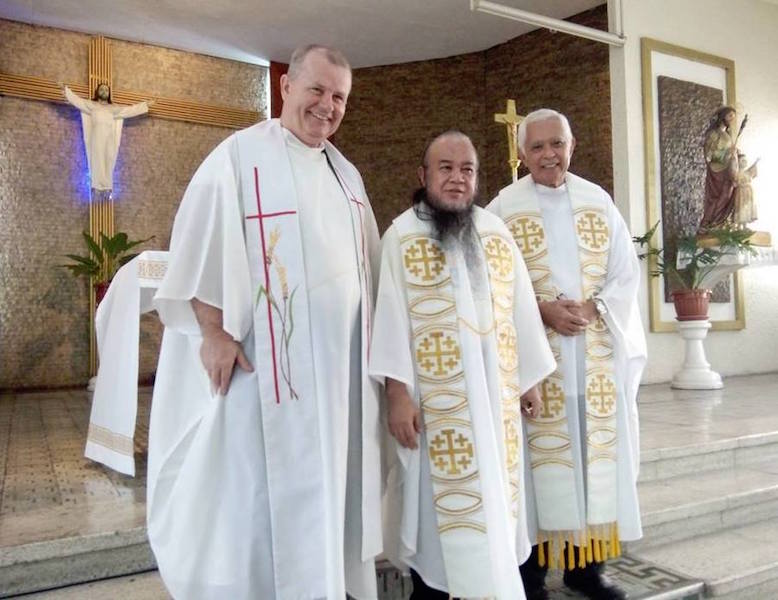 Hostage survivor Fr. Teresito “Chito” Soganub, with Fr. Rodulfo “Gong” Galenzoga, (R) who introduced him to Lanao del Norte, and eventually to Lanao del Sur where he served all of his 23 years as priest in Marawi City. Photo taken during the sacerdotal anniversary mass of F. Chito in October 2017 at the Immaculate Heart of Mary School in Sta. Mesa, Manila. Photo courtesy of MILET MENDOZA
Hostage survivor Fr. Teresito “Chito” Soganub, with Fr. Rodulfo “Gong” Galenzoga, (R) who introduced him to Lanao del Norte, and eventually to Lanao del Sur where he served all of his 23 years as priest in Marawi City. Photo taken during the sacerdotal anniversary mass of F. Chito in October 2017 at the Immaculate Heart of Mary School in Sta. Mesa, Manila. Photo courtesy of MILET MENDOZA
Galenzoga did not confine himself within the Prelature of Marawi and the Diocese of Iligan where he once headed the Interreligious Dialogue ministry. He served as Executive Secretary of the Mindanao Interfaith Pastoral Conference which allowed him to go around Mindanao, giving him the “privilege of witnessing and being edified by the committed action of the laity, be they in the Church or in NGOs” and working “for and with many sectors and communities, especially the Muslims and Lumads,” making him realize, he said, “that ours was really the struggle for the land and for love, freedom and life.”
In 2011, the San Jose Seminary Alumni Association conferred on Galenzoga the San Jose Award in recognition of his commitment to interreligious dialogue and service among the Muslims and Lumads (indigenous peoples) of Mindanao.
Maranatha
Fr. Alberto de Lara, of the Holy Cross Parish in the municipality of Kolambugan, concurrent Vicar General of the Diocese of Iligan, describes Galenzoga as a man who “loves peace and unity among different cultures and religion, a champion of dialogue.”
De Lara said Galenzoga retired at age 70 and had since stayed at Dapit-Alim.
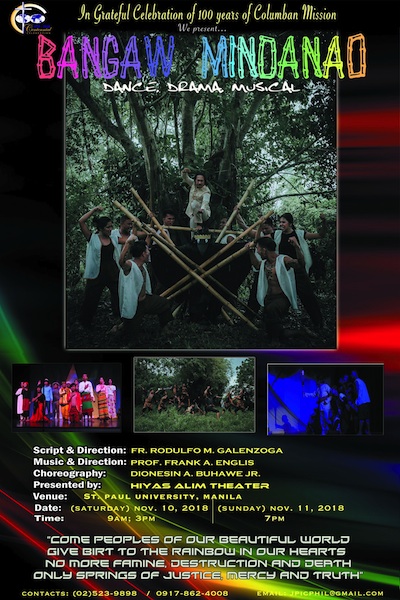 Kolambugan Mayor Lorenzo Mañegos recalls that Fr. Dong, playwright and director, organized the Kolambugan Dance Theater in the 1970s and mounted the musical “Maranatha.
Kolambugan Mayor Lorenzo Mañegos recalls that Fr. Dong, playwright and director, organized the Kolambugan Dance Theater in the 1970s and mounted the musical “Maranatha.
“Maranatha” made over 135 performances in its nationwide tour in 1974 and 1975. The play had been described as having used “an old Lanao tale about a big, black, predatory bird, to expose corruption of politicians and the growing militarization in Mindanao.”
Galenzoga said the years of conflict, of immersing in what he described as the “fiery wounds” of Mindanao made them more creative. They set up the KRISKA or Kristohanong Kasilinganan as their contribution to what was then developing as Basic Ecclesial Communities movement in Mindanao, making use of songs and dance dramas as “powerful media of evangelization.”
“Maranatha” was also toured by performing MSU-CSO (Mindanao State University-Catholic Students Organization) students in the early 1990s in the cities of Zamboanga, Cotabato and Jolo with a mixed cast of Muslims and Christians. The dance-drama was re-titled “Kalilintad Anda Ka” (Peace Where Are You?).
The then newly-founded community theater at Kahigalaan ni Hesus (KH) Dapit-Alim brought “Maranatha” to some towns and cities of the Visayas and Mindanao in the early 2000s.
Fr. Dong updated “Maranatha” in 2018 and renamed it “Bangaw Mindanao,” bangaw referring to grand feast or rainbow. “Bangaw” depicts the present plight of the peoples in Mindanao – the Lumads, Muslims and Christian settlers, their dreams and struggles for justice and peace.
“A truly living faith in action”
Writing on Galenzoaga’s demise, Redemptorist Brother Karl Gaspar said: “We are poorer now that he is no longer physically among us …especially his family, his community in Dapit-Alim, the Muslim and Christians reached out through his interfaith engagements, the community theatre network which he pioneered, and all of us who collaborated with him to make the Local Church of Mindanao a truly living faith in action, responding to the needs of the least among our sisters and brothers .. as well as our corner in this planet to make Mindanao a haven of peace solidarity, compassion and justice. Rest well Dong … and we know you have now embraced the home of God of your faith which you have always known is your final destiny!”
Fr. Eliseo Mercado, Jr. described Galenzoga as “a man deeply committed to interreligious dialogue.”
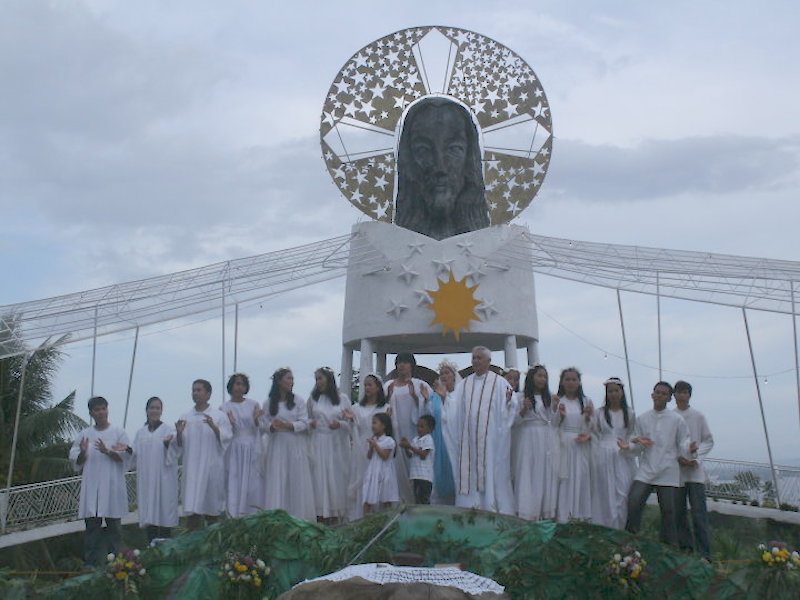 The Cosmic Christ sculpture by Kublai Millan is one of the landmarks in Dapit-Alim. Photo courtesy of Dapit-Alim
The Cosmic Christ sculpture by Kublai Millan is one of the landmarks in Dapit-Alim. Photo courtesy of Dapit-Alim
Fr. Galenzoga’s remains, according to the Chancery, will be brought to Dapit-Alim on Monday. Interment will be at 3 p.m. on Friday, March 19, Feast of St. Joseph, the mass to be presided by Iligan Bishop Jose Rapadas. (Richel V. Umel, Bobby Timonera, and Carolyn O. Arguillas / MindaNews)
